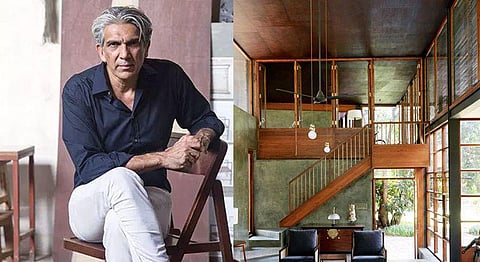
- #HGCREATORS
- #HGEXPLORE
- #HGVOICES
- #HGSHOP
- CAREERS
- ABOUT US
- CONTACT US

Between its sprawling buildings, congested streets and rapidly growing population, the beating heart of Mumbai is full of unbridled opportunity and unrealised dreams. It’s a city of contrasts – the rich and famous perched atop a life of fluctuating glamour, amidst humble masses on precarious motorbikes, riding on broken concrete to 16-hour workdays. It’s not always easy to find beauty in this chaos, or space to exist in harmony with the elements so essential to our world.
Bijoy Jain, an international award-winning architect and founder of Studio Mumbai, is a visionary whose work has not only transcended conventional understandings of space and architecture, but has also forged itself as an emotionally-charged, ethically grounded approach to art.
He studied in the United States, worked in London and then returned to Mumbai to create his own architectural practice in 2005. He was a visiting professor of architecture at Yale university and his installations have gained worldwide recognition in many biennales and museums, but Bijoy is a man of simple taste with a calm demeanour.
His designs, structures and spaces, across India and the world, combine tradition and history with simple modernity – most importantly, they reflect and are inspired by the environment within which they are situated. They are created from a relationship with our senses, our elements and our physical surroundings: water, air, light, gravity. Using only locally sourced materials, traditional building methods and local labour, every piece and every place is a deeply philosophical experience that resonates with the moment it’s in, free of any constraints or impositions.

“The only thing that’s constant is change,” he tells me as we look at a large painting in his workshop – a canvass made from bamboo and dried cow-dung, strewn with lines of dried vermillion pigment – part of his 2018 exhibition, Abhaya. “At any given moment, this painting is finished. You can add or subtract from it constantly, but whenever you look at it, in that moment in time, it’s a complete piece. Who is to say it’s not? Today I like it, but tomorrow I want to whitewash the whole thing and start over. The important thing is that it always remains open to the movement of time and change. We live in constant flux and we should not fear that.”
It’s the same spirit with which all his architectural projects manifest. Studio Mumbai designs buildings around the world, but on the sole conditions that “the project can take the time it needs” and work with only local artisans. At his breathtaking Byculla office (and home), his team comprises more carpenters and stonemasons than architects. He doesn’t always use traditional approaches to building – like using blueprints and plans. In order to communicate most effectively with his labourers, who come from all parts of the city and from various socioeconomic backgrounds, he developed an inclusive and collaborative approach to each project.

Bijoy’s work is inherently sustainable, but should be seen as part of his intrinsic artistic sensibility rather than a conscious, trending choice towards “going green.” In fact, Italian architect Nicola Scardigno told the Guardian: “traditional architecture was already sustainable” and that it is “unrealistic to entrust terms like zero-energy development, bioclimatic architecture, eco-buildings, and low carbon footprint with the responsibility of solving the environmental agreement between man and nature”.
“I don’t believe architecture can save the world but it can resonate with the essence of a particular space. This is what we are all confronted with. And it is all about how we negotiate gravity that gives architecture its form. For me, architecture is a moment in time,” Bijoy once said to ArchDaily.
To me he describes his love for the craftsmanship of the monks who carved the Ajanta-Ellora caves and how it inspires his philosophy of creation and destruction. “It’s amazing that these little structures took centuries to carve. You can go there and touch something that’s two thousand years old, imagine how much power this thing has even though it’s totally imprisoned in the bureaucracy of politics. It’s not allowed to express itself but it’s alive – it exists in stillness, in silence.”
I ask him what he thinks the future of sustainable architecture will be in a city developing as rapidly and inorganically as Mumbai. “There’s a part of me that’s hopeful, and another part that’s unsure. The politics of this city will not let it change for a while. The BMC, the government… their motivation is to make money. But we cannot approach this with hopelessness, because then you’ve already lost. The intention of the practice matters, and everyone’s is different. I don’t want to be caught in my own bias. But it’s about reciprocity and change. Entire civilisations have come and gone, and the materials we use tell these stories – just look at Ajanta-Ellora.”
If you enjoyed reading this, we suggest you read:
